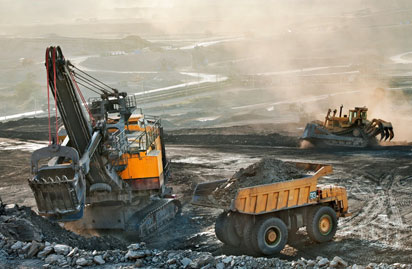Manufacturing in India is one of the most promising sectors while India moves to a manufacturing economy from an agricultural and a service economy. With Prime Minister Modi’s ‘Make in India’ program to the world, India has been put on the world map as the manufacturing hub and has given global recognition to the sector. India could become the fifth largest manufacturing country in the world by the end of the year, aiming to achieve 25% GDP share from the current 16%, and creating 100 million new jobs by the end of 2022.
To achieve sustainable growth and broad development, the Indian Government needs to provide stimulus to the manufacturing sector. No country has become a major economy without becoming an industrial hub, take for instance China, the country has become the manufacturing centre of the world in the last 30 years, and has climbed up to become the second biggest economy in the world. A push to the manufacturing sector is much needed to achieve an inclusive and sustainable growth. As a country with a population projected to increase to more than 1.4 bn by 2022, India has an incredible human potential. The demographics will help India achieve growth in the manufacturing sector, given that India has a huge young population. The 185Mn additional workforce (according to Niti Aayog) that are expected to join the workforce in the next 15 years cannot be employed by the services sector alone. To take full advantage of this demographics and to unlock the human potential, India needs to strengthen its manufacturing sector.
Various studies estimate that every job created in the manufacturing sector has a multiplier effect in creating 2–3 jobs in the service sector. In India, Job creation has been one of the key policies focuses, this makes the manufacturing sector a critical sector to achieve inclusive growth.
The IHS Markit India Manufacturing PMI rose from 52.7 in December 2019 to 55.3 in January 2020, its highest level in just under eight years. (In PMI parlance, a score above 50 means expansion, a score below that denotes contraction)
The Gross Value Added (GVA) at basic current prices grew at a CAGR of 4.29% during FY12 and FY19 as per the annual national income. The sector’s GVA at basic prices based at current prices is estimated at US$ 403.47Bn in FY19PE. Business conditions in the Indian manufacturing sector continue to remain positive. India’s overall exports in April-November 2019-20 are estimated to be US$ 353.96Bn.
Companies in the manufacturing sector have been growing at a strong pace because of the underlying demand and greater client requirements as well as from external markets, a growing middle class, a young population and a high return on investment.
New business growth and projects in the pipeline have been major factors in generating employment in the country.
Slower increases in input costs and output charges in prices contribute to the positive outlook of the industry.
Make in India:
This campaign has emerged as an important aspect with an all-inclusive slant to take India to a new level of economic growth. The 25 sectors that have been recognized under the campaign offer a range of prospects for investment. Additionally, a rigorous plan is underway to reform policies in the identified sectors to provide support and stimulus to the manufacturing sector growth.
This program has provided fresh stimulus to the identified sectors and has offered companies worldwide a wide opportunity for investments, and opportunities in terms of partnerships, collaborations / joint ventures, R&D, manufacturing etc.
Structural transformation:
- Ease of Doing Business
- Facilitating investment
- Fostering innovation
- Strengthening of Indian IPR regime
- Labour and land reforms
- Taxation reforms
Government Initiatives:
The Government has taken several initiatives to promote the growth of manufacturing sector in the country. Some of the notable initiatives are:
- 100% FDI in contract manufacturing through automatic route
- National Policy on Electronics (NPE) was passed, which envisions creation of a US$ 400 billion electronics manufacturing industry by 2025, 32% growth rate has been targeted globally in next 5 years
- Government has exempted 35 machine parts from basic custom duty to boost mobile devices production
- Government coming up with a new industrial policy which envisages development of a globally competitive Indian industry
- Under the Mid-Term Review of Foreign Trade Policy (2015-20), the Government increased export incentives available to labour intensive MSME sectors by 2%
- Government launched a phased manufacturing programme (PMP) to add more smartphone components under the Make in India initiative
- Easing foreign direct investment (FDI) in defence sector, under the automatic route to 51% from the current 49%
- Government has approved Strategic Partnership model, which will allow private companies to partner with foreign players for manufacturing submarines, fighter jets, helicopters and armoured vehicles
Investments:
With Make in India, India is becoming the centre for hi-tech manufacturing as global titans such as Apple, GE, Samsung etc. have set up or are in process of setting up manufacturing plants in India, attracted by more than a billion consumers and increasing purchasing power of the middle class.
Cumulative Foreign Direct Investment (FDI) in India’s manufacturing sector reached US$ 91.20Bn during April 2000-June 2019.
Some of the major recent developments in the sector are:
- In September 2019, Mumbai got its first metro coach manufactured by state-run Bharat Earth Movers (BEML) under Make in India initiative
- In August 2019, Vivo announced investment of around US$ 480Mn in India to expand capacity
- Smartphone maker OnePlus anticipates that India will become its largest R&D base soon
- Filatex India, a polymer manufacturer, is planning to undertake forward integration by setting up a fabric manufacturing and processing unit
- IISC’s Society of Innovation and Development (SID) and WIPRO 3D are collaborating to produce India’s first industrial scale 3D printing machine
Covid-19 Crisis:
India is witnessing a rise in coronavirus, termed as Covid 19, cases with over 1,000 cases reported so far. The virus has not only diseased humans but has also shaken the world economy, disrupting almost every sector, mainly the manufacturing sector.
After China, Italy is the worst-hit region. Governments around the world have imposed quarantine and it seems like the entire world is in a lockdown state.
India has been one of the worst hit countries, with the country in a lockdown and new cases being reported every day. India has shut down everything but the essentials, which means that the economy would take a big hit. The worst hit sector would be the manufacturing industry, with all plants and industries shut down. Many industries are sailing through one the worst times ever, when they have their fixed bills and salaries to pay. The worst hit would be the MSME and the start-up sector, wherein people are being laid off and the promoters foresee a tough time if the lockdown is extended beyond a 21 days period. Industries would not be able to their employees beyond this time. Almost 5Mn people lost their jobs after the Covid-19 outbreak in China.
The first case of coronavirus in India was confirmed in January 2020 that spread panic amongst the people. China, being the epicentre of the corona virus, shook up the manufacturing sector in India, which is dependent on procurement of raw materials from China. By March 30, Indian Ministry of Health and Family Welfare confirmed over 1,000 cases of Covid-19 and over 25 deaths.
A US$ 5Tn economy seems like a far- fetched dream for India in such times now. Rules, obligations are being issued by the government daily, and each is impacting one industry or the other.
With exports hit hard because of the lockdown across the world and disruption of the supply chain due to the lack of raw material from China, manufacturing sector would be hit the worst. India’s dependence on procurement of raw materials from China across sectors has created a disruption in the supply chain, thus creating a massive slowdown in the Indian manufacturing sector. Moreover, industries are not being able to survive with the fixed costs like wages and rents.
There has been a discussion across the globe about China Plus One, wherein the world leaders would like to reduce dependence on China for raw material. This seems to have more relevance than ever now in the corona virus scenario. Looking forward, post a corona virus world, this seems to be a golden opportunity for India, wherein India should look to capitalize on becoming the second option for the world as a manufacturing hub, leveraging the biggest asset the country has to offer, its huge population.
The government would have to step in to help the sector with a fresh stimulus to fight the corona virus phase. Post this phase, the Indian manufacturing sector presents a golden opportunity as an alternative to the Chinese market, to reduce dependence. The economy would take at least two quarters to recover from this phase, but post that there should be a massive inflow of investments in the manufacturing sector.
Before Coronavirus, India presented itself as an attractive destination for foreign investments in the manufacturing sector. Several mobile phone, luxury and automobile brands, among others, have set up or are looking to establish their manufacturing bases in the country.
The manufacturing sector of India can reach US$ 1Tn by 2025. The implementation of the Goods and Services Tax (GST) will make India a communal market with a GDP of US$ 2.5Tn along with a population of 1.32Bn people, which will be a big attraction for investors.
With push on developing industrial corridors and smart cities, the government is pushing for holistic development. The future of Indian Manufacturing remains positive in the coming years. Global economic scenario as well as the steps taken by the Government impact performance in the manufacturing sector in the short, medium and long term, with short term being a little vary but the medium and long term looking bright for the sector.






